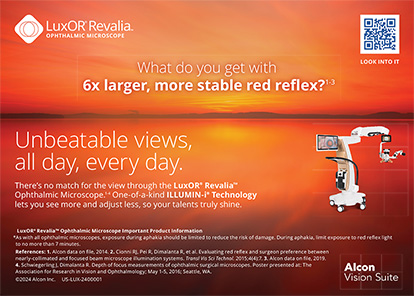Patients judge their surgeons by their outcomes, so I want to have the best possible result for all of my patients, whether or not they are selecting advanced technology and are paying a premium. I know that, if my patients are happy, my practice will grow. Although a number of exceptional new technologies may increase the predictability of cataract surgery, I have developed a protocol that helps me obtain the best possible outcomes using standard technology. Even small amounts of residual astigmatism or refractive error can degrade the visual outcomes of cataract surgery. I have found that the most important step to reduce astigmatism and achieve the best results is to decouple the cataract consultation from the surgical testing appointment.
CATARACT CONSULTATION VERSUS PREOPERATIVE MEASUREMENTS
During the cataract consultation, I focus on judging the visual significance of the lenticular opacities in addition to assessing the ocular surface, the cornea, the lid margins, and the posterior pole. I test every patient's tear osmolarity and evaluate the corneal surface with lissamine green. I instruct patients to discontinue wearing their contact lenses. I initiate an individualized treatment regimen to optimize the ocular surface. This may include omega-3 oral supplements, cyclosporine 0.05% ophthalmic emulsion (Restasis; Allergan), azithromycin ophthalmic solution (AzaSite; Merck & Co, Inc.), and a corticosteroid, loteprednol gel or ointment (Lotemax; Bausch + Lomb). In addition, I start all patients on preservative-free artificial tears q.i.d. until their biometry appointment, which helps them become comfortable instilling drops in their eyes while lubricating the ocular surface.
My office schedules the surgical testing appointment to take place a minimum of 2 weeks after the cataract consultation. A senior ophthalmic assistant performs manual keratometry using a dedicated keratometer that is calibrated daily; keratometry measurements are also obtained using optical biometry and topography. If there is more than a 10º difference in the axis or a greater than 0.50 D difference in the overall amount of cylinder between the three instruments, the difference needs further explanation.
It is important to assess not only the overall degree of astigmatism but also the pattern. If astigmatism is greater than 1.25 D and symmetrical, the patient may be a good candidate for a toric IOL. If his or her astigmatism is low, asymmetrical, or irregular, a limbal relaxing incision (LRI) may be a better option.
USING LRIs
In patients who have between 0.51 and 1.25 D of astigmatism, I perform a LRI. I use the Wallace LRI Nomogram, because in patients with low levels of cylinder, the formula requires a single arcuate incision rather than paired incisions. Fewer cuts are safer due to less injury to corneal nerves. Using a diamond blade, I perform the LRI at the beginning of the surgical case. LRI nomograms are based on an average amount of corneal flattening for a certain length of incision. Not every person falls into the bell curve, and patients may get more or less of an effect than planned. My goal is to leave each patient with less than 0.50 D of corneal astigmatism.
CORNEAL SPHERICAL ABERRATION
In addition to astigmatic correction, I also try to match the patient's corneal spherical aberration (SA) with the SA of available implants as closely as possible. Although the data are still inconclusive, some studies have demonstrated that aspheric lenses induce less higher-order aberration and SA, resulting in better contrast sensitivity in patients.1 In patients who select monofocal IOLs and have a positive corneal SA of at least +0.27 μm, I use the Tecnis ZCB00 IOL (Abbott Medical Optics Inc.) with -0.27 μm SA.
CASE EXAMPLE
A 74-year-old man presented with a complaint of blurred vision in his right eye. He had undergone cataract surgery in his left eye 4 years ago. He had a refractive error of -2.00 +1.25 × 10 and a BCVA of 20/30 OD, yet he had an abnormal functional vision analyzer (VectorVision) result of 20/70 with glare in his right eye.
His keratometry readings were 44.12/45.37 × 005 OD. On the axial map, a spherical aberration of 0.300 is present (Figure). This patient declined a toric IOL due to the out-of-pocket cost; it therefore made sense to select the ZCB00 and perform an LRI. He was willing to pay for the LRI, because it was less expensive than the toric IOL.
The patient underwent uncomplicated cataract surgery with an LRI based on the Wallace nomogram. I performed the LRI at the start of surgery before I made the sideport incision. The patient had a final refraction of plano sphere with a visual acuity of 20/20 OD at the 4-week postoperative visit and keratometry readings of 44.00/44.37 × 100 OD.
The patient said that he was very pleased with his visual outcome, that he could do all tasks without spectacle correction, and that he “never wears glasses,” because I had aimed for near vision in his left eye in 2009 with planned monovision.
CONCLUSION
My approach to cataract surgery is to obtain precise results from keratometry and topography through the optimization of the ocular surface. By separating the cataract consultation from the surgical appointment by at least 2 weeks, I can treat the ocular surface before acquiring the measurements that will guide LRIs and toric IOL power calculations or determine corneal spherical aberration. My patients' satisfaction rates reflect this careful planning.
Cynthia Matossian, MD, is the founder and CEO of Matossian Eye Associates with offices in Pennsylvania and New Jersey, and she is a clinical instructor/adjunct faculty member at Temple University School of Medicine in Philadelphia and Robert Wood Johnson Medical School in New Brunswick, New Jersey. She acknowledged a financial interest in Abbott Medical Optics Inc.; Allergan, Inc; and Bausch + Lomb. Dr. Matossian may be reached at cmatossian@matossianeye.com.
- Tzelikis PF, Akaishi L, Trindade FC, Boteon JE. Spherical aberration and contrast sensitivity in eyes implanted with aspheric and spherical intraocular lenses: a comparative study. Am J Ophthalmol. 2008;145(5);827-833


